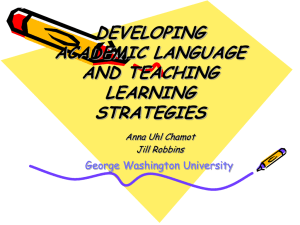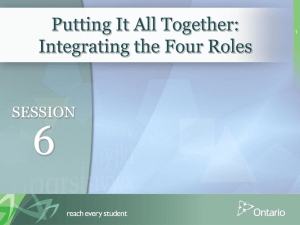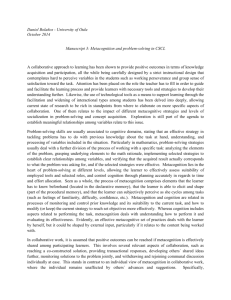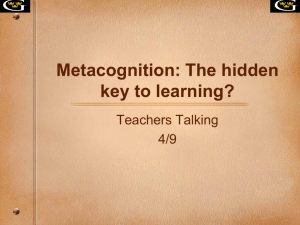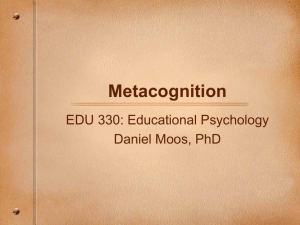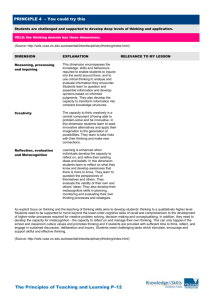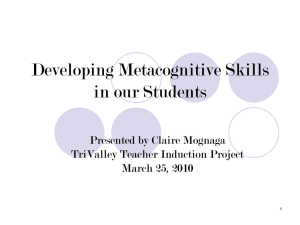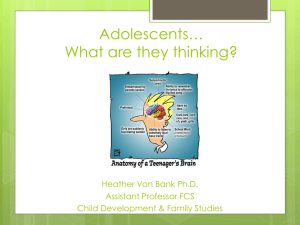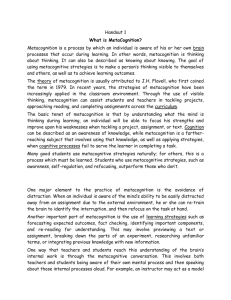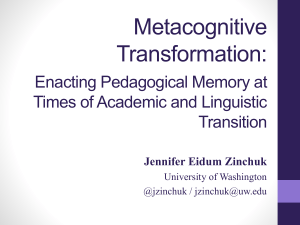`Effective Questioning: Stepping-Stones to Meta
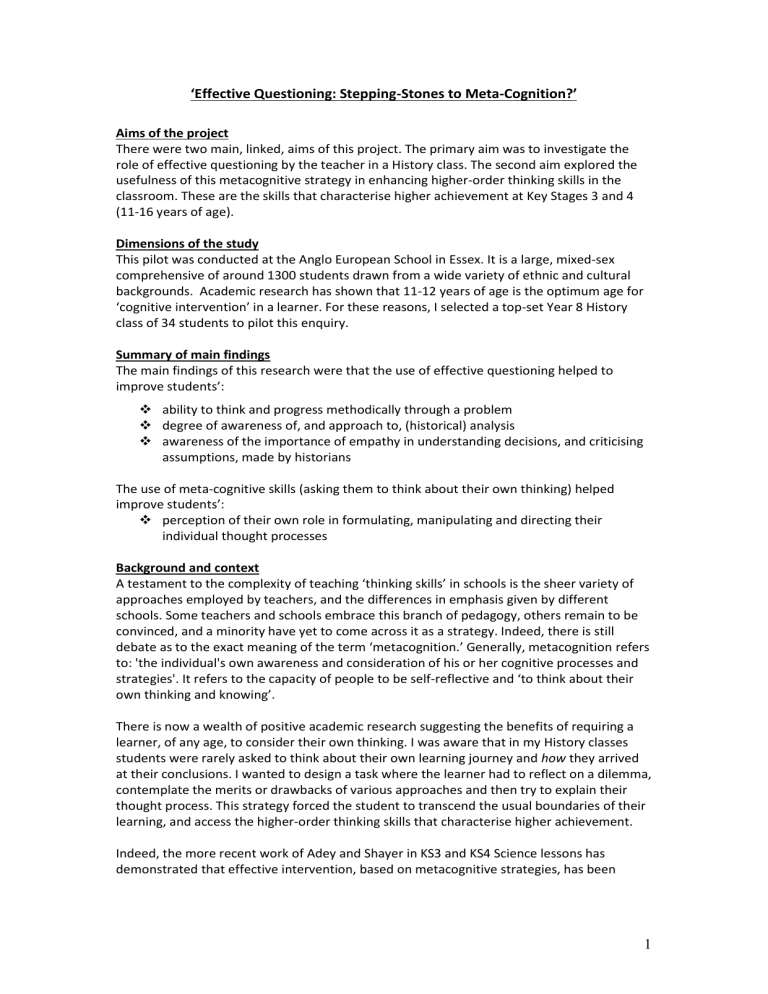
‘Effective Questioning: Stepping-Stones to Meta-Cognition?’
Aims of the project
There were two main, linked, aims of this project. The primary aim was to investigate the role of effective questioning by the teacher in a History class. The second aim explored the usefulness of this metacognitive strategy in enhancing higher-order thinking skills in the classroom. These are the skills that characterise higher achievement at Key Stages 3 and 4
(11-16 years of age).
Dimensions of the study
This pilot was conducted at the Anglo European School in Essex. It is a large, mixed-sex comprehensive of around 1300 students drawn from a wide variety of ethnic and cultural backgrounds. Academic research has shown that 11-12 years of age is the optimum age for
‘cognitive intervention’ in a learner. For these reasons, I selected a top-set Year 8 History class of 34 students to pilot this enquiry.
Summary of main findings
The main findings of this research were that the use of effective questioning helped to improve students’:
ability to think and progress methodically through a problem
degree of awareness of, and approach to, (historical) analysis
awareness of the importance of empathy in understanding decisions, and criticising assumptions, made by historians
The use of meta-cognitive skills (asking them to think about their own thinking) helped improve students’:
perception of their own role in formulating, manipulating and directing their individual thought processes
Background and context
A testament to the complexity of teaching ‘thinking skills’ in schools is the sheer variety of approaches employed by teachers, and the differences in emphasis given by different schools. Some teachers and schools embrace this branch of pedagogy, others remain to be convinced, and a minority have yet to come across it as a strategy. Indeed, there is still debate as to the exact meaning of the term ‘metacognition.’ Generally, metacognition refers to: 'the individual's own awareness and consideration of his or her cognitive processes and strategies'. It refers to the capacity of people to be self-reflective and ‘to think about their own thinking and knowing’.
There is now a wealth of positive academic research suggesting the benefits of requiring a learner, of any age, to consider their own thinking. I was aware that in my History classes students were rarely asked to think about their own learning journey and how they arrived at their conclusions. I wanted to design a task where the learner had to reflect on a dilemma, contemplate the merits or drawbacks of various approaches and then try to explain their thought process. This strategy forced the student to transcend the usual boundaries of their learning, and access the higher-order thinking skills that characterise higher achievement.
Indeed, the more recent work of Adey and Shayer in KS3 and KS4 Science lessons has demonstrated that effective intervention, based on metacognitive strategies, has been
1
proven to achieve distinct and measurable gains in assessments at KS4.
1 It has also been seen to improve students’ self-esteem and their ability to interact more meaningfully in group situations. Intervening at the critical stage in the learner’s neural development (11 –
12 years of age) appears to have long-lasting effects upon how they approach learning, and the success that they experience in other contexts. Indeed, as Adey and Shayer have concluded: ‘It is not what you learn that is important, but how you learn it’.
Teaching and learning processes and strategies
The students had made some preliminary studies on Mary I where they had the opportunity to study the background to her reign. They were then asked to assess three courses of action open to Mary regarding the religious problems that she faced (try to reform and improve the
Catholic church; make an alliance with a Catholic country; try to force Catholicism on the country), and make a decision on which they would advise Mary to follow. The point of this task was to encourage reasoning based upon the use of effective questioning. The following example by a student demonstrates this:
(IMAGE)
Using a structured format of questioning (‘who’, ‘what’, ‘why’ and ‘how’), I was able to encourage consistency in the way the students approached the respective dilemmas that they were considering, which then allowed them the opportunity to deploy their historical reasoning to each choice.
This questioning technique provided the critical foundation necessary to tax the metacognitive skills of the learners. After the initial task, the students were then asked, if they could, to explain how they reached their decision (the metacognitive aspect). A few found it too difficult and were not able to distinguish between explaining why and how nor could they articulate their thinking. This was an important finding. However, an overwhelming majority were able to do this and appeared to thrive on it:
“I think this type of thinking is very helpful and interesting because you are making lots of decisions and thinking about why you think this. It makes you go down different paths and stretches your brain”. (Ellie) Ellie’s comments are illuminative because they show her consciousness of her own decision-making process, and how this is helping her forge different paths in her learning.
After this individual task, students worked in a group to decide on a course of action for
Mary. It was particularly revealing to hear how competent the students were at interacting and explaining the pros and cons of each choice. It was also interesting to see the groups retrace the steps in their thought when explaining how they arrived at their choice. There is little doubt in my mind that this collaborative task was helpful in building my students’ metacognition.
For homework the students wrote a response to the following question:
‘Did you find this type of thinking (metacognition) interesting and helpful?’
1 Adey and Shayer (1994)
2
The following is a selection of their responses. They indicate not only that the students found the approach rewarding and engaging, but also demonstrate the type of thinking that students were using.
“I find the method of thinking about how I got an answer is odd. I’ve never done it before,
I’ve just written down the answer. But if you write down your method, you actually have to think about how you got your answer. You have to think about what you thought about.
Weird”. (Jack)
“I find this way of thinking very different and interesting. It is not that often that people delve deep into their own minds and question their own thinking instead of others. I like the fact that it is different to anything that I have done before, and I believe that by using this method it challenges the mind and in time it helps it to grow”. (Chloe)
Such insightful reflection demonstrated to me that my students were beginning to conceive of thinking in a very different way than prior to the pilot. Chloe displays the traits of a learner who is conscious of her own thought processes, and the control that she has over their shape and direction. The evidence indicates that usual assumptions about knowledge and ability being fixed (a standard barrier to student development) are beginning to be questioned. This was particularly encouraging.
“I found this type of thinking interesting. It made me wonder about my answer and was I sure I got my facts right”. (Georgina)
“Yes I found this type of thinking helpful and interesting because I found it puts your brain much more in focus and concentration. It also allows you to think much more into History by following paths and stepping-stones”. (Scott)
The findings
Students liked the structure that the scaffolded questions gave them. For example, a student explained: “I find this step-by-step way of thinking quite convenient and also makes me think about my final decision” (Thalia)
This questioning model has enabled some students to develop a methodology for approaching dilemmas, and enhanced their awareness of the decision-making process
In a group setting, the learners enjoyed discussing collectively the rationale for making their selection, and their eventual consensus after talking about their communal thought process
Students displayed a conscious awareness of their own thought patterns
Students recognised that they could apply the method in other circumstances: “If you look back at how you worked out an answer, you can check very precisely for mistakes and see if you’ve gone wrong. You can then use the method you use in your head to do other questions. In all, I think that this is really helpful” (Jack)
Metacognitive group work seemed to offer the potential for cross-curricular development
Research methods
The method of enquiry and data collection was relatively straightforward. I collected and analysed the written work and feedback from the students. I used it to gauge the effectiveness and overall impact of the questioning model as a basis of a strategy to enhance
3
students’ metacognition. This did, of course, have its limitations, most specifically that it does not account for, or assess, the longer-term impact of such strategies.
Conclusion
Students’ feedback was overwhelmingly positive and showed that the majority of the learners themselves believed that these thinking skills were effective, helpful and interesting. However, this study certainly affected the way that I teach and the level of metacognitive strategies that I employ. There are further areas where this study has shed some light. For example, could these strategies be applied across the ability range? How exactly would they have to be modified for lower-ability students and would they have the same impact? Could it be used in a cross-curricular fashion, and how could it be adapted for younger children at KS1 and 2? Could students carry this approach, these ‘thinking skills’, with them to every subject - much like a school-bag or pencil case? Could these thinking skills be a generic template that teachers use to improve the higher order thinking skills of their students, irrespective of the subject?
The conclusion of this enquiry is that effective questioning is crucial in providing the structure and capacity for developmental learning and enhancing the meta-cognitive skills of learners. Indeed, it is my belief that metacognition is itself an under-used and under-valued approach. If our aim is to produce reflective, free-thinking and independent learners, then metacognition is undoubtedly a valuable tool in helping us achieve this.
Suggestions for further reading
Adey P. & Shayer M (1994) Really Raising Standards: Cognitive intervention and academic
achievement, London: Routledge
Fisher J. (1995) Thinking about Thinking: Developing Metacognition in Children: Stanley
Thornes
Fisher P. & Wilkinson I Thinking through History (Ed. D Leat) ISBN: 1 899857443180ppA4
Metcalfe J. & Shimamura A.P. (1996) Metacognition; Knowing about Knowing, Cambridge.
Mass: MIT Press
Author and contact details
Andrew Price
The Anglo European School
Willow Green
Essex
CM4 0DJ
4
